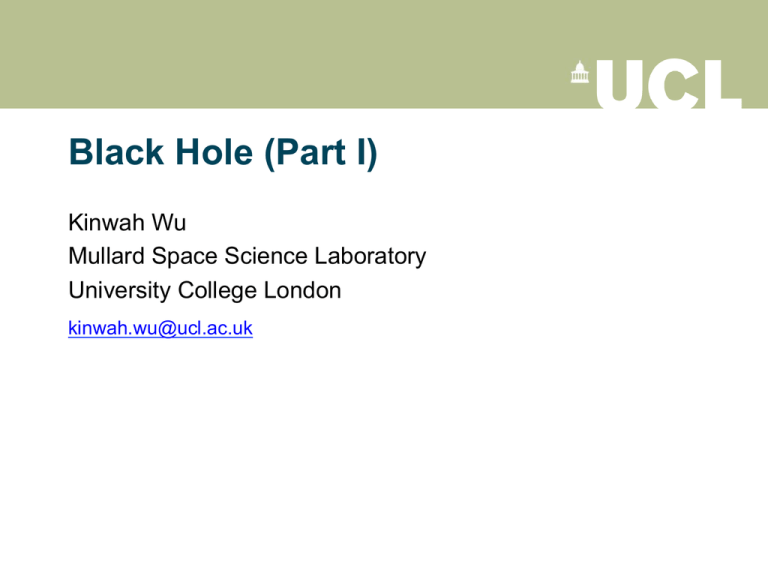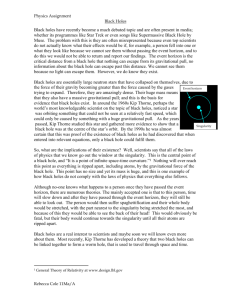Black Hole (Part I) Kinwah Wu Mullard Space Science Laboratory University College London
advertisement

Black Hole (Part I) Kinwah Wu Mullard Space Science Laboratory University College London kinwah.wu@ucl.ac.uk Black hole as known by radio observers Image credit: (left) NRAO; (right) HST/STScI Black hole according to some scientists Image credit: NASA/JPL-Caltech Black hole – the Hollywood version Image credit: Interstellar Black hole that I see (on wednesdays) Image credit: London Underground Black holes that I found on Youtube Image credit: (left) MUSE; (right) Sony Music What does wikipedia say about “black hole”? “A black hole is a geometrically defined region of spacetime exhibiting such strong gravitational effects that nothing including particles and electromagnetic radiation such as light can escape from inside it.” Content • • • • • • • • • • • • • Astrophysical black holes What is a black hole – the “standard” view? Space-time around a black hole Imaging black holes Black-hole thermodynamics (very basic) Spinning objects around a black hole Black holes, white holes and worm holes Kruskal construct, Penrose diagram … etc More on black hole space-time and its stability Physical system analogs of black holes Hairy black holes and related issues Quantum states of black holes Holography and information paradox 1. Astrophysical black holes Astrophysical black holes Stellar mass black holes as end point of the evolution of very massive stars Image credit: Wikipedia Astrophysical black holes Stellar mass black holes as end point of the evolution of very massive stars Image credit: unknown Astrophysical black holes Stellar BH in X-ray binaries, e.g. GRS1915+105 Image credit: (left) NRAO, F. Mirabel & L. Rodrigueez; (right) J. Blondin Astrophysical black holes Sgr A*: A four-million solar-mass black hole residing at the Galactic Centre (Ghez etal. 2008; Meyer et al. 2012) Astrophysical black holes Supermassive black holes that power quasars and AGN, e.g. in M87 Image credit: NASA & the Hubble Heritage Team (STScI/AURA) Astrophysical black holes Power produced by accretion of matter into a black hole GMbh E = m R dE GMbh 2 = ṁc = dt c2 R dE L ⇡ dt ṁ = 10 8 M yr ṁ = 1 M yr 1 ⇡ 1.3 ⇥ 10 ⇠ L 1 ⇠ L Eddington luminosity LEdd ⌘ ṁc2 38 ✓ M M ◆ ⌘ 6 ⇥ 1037 erg s 6 ⇥ 1045 erg s erg s 1 ⇠ 1 1 0.1 Astrophysical black holes Ultra-luminous X-ray sources (ULX) as intermediate-mass black hole-candidates, e.g. ULX-1 in the M101 galaxy Image credit: CXO/Spitzer/HST/GALEX Astrophysical black holes Black-hole systems as generators cosmic rays Image credit: (left) IceCube Collaboration; (right) I. Jacobsen Astrophysical black holes M-σ relation: indication of co-evolution of black holes and their hosts (Gueltekin et al. 2009) Astrophysical black holes Black holes and cosmological reionisation quasars stars (Thomas et al. 2009) Astrophysical black holes Neutron star – neutron star mergers and black hole – black hole mergers as gravitational wave sources Image credit: C. Reisswig & L. Rozella 2. What is a black hole? What is a black hole? Escape velocity K = K = v2 GM 2 r (M/R) 0 ) vesc = 617.5 km s (M/R) Earth 11.2 km s Moon 2.4 km s ⇡ (500 Milky Way 1 1 1 600) km s 1 Event horizon: location where escape velocity is equal to the speed of light ! vesc rs = c = 3.0 ⇥ 105 km s 2GM c2 1 Schwarzschild radius What is a black hole? Black hole – the basic idea (according to Laplace) rs rs 2GM = c2 > Robj event horizon: a critical surface within which light is trapped Robj rs In a Laplacian black hole light can cross the event horizon from within but it is just that the light from the region within is not allowed to escape to infinity What is a black hole? A “no-frills” black hole – the Schwarzschild black hole o spherical o a point singularity at the centre o an event horizon at the Schwarzschild radius singularity event horizon In a relativistic black hole light cannot cross the event horizon from within and it is trapped inside forever What is a black hole? No-hair theorem/conjecture: we need only three classical parameters (mass, angular momentum and electric charge) to specify a stationary black hole Four kinds of black holes non-rotating (J = 0 ) rotating (J > 0 ) uncharged (Q = 0) Schwarzschild Kerr charged (Q > 0) Reissner-Nordström Kerr-Newman • Only Kerr black holes and Schwarzschild black holes are relevant in astrophysics • If magnetic charges (monopoles) exit, there will more than 4 kinds of black holes What is a black hole? Kerr black hole o not appear to be spherical o a ring singularity at the centre o two event horizons ring singularity static limit inner event horizon outer event horizon ergosphere What is a black hole? Black hole, grey hole or pink hole? rs ⇡ 3 ⇥ 105 ✓ M M ◆ M = 1.989 ⇥ 1033 g cm M = 5.972 ⇥ 1027 g ⇡ 3 ⇥ 10 6 M Collapsing an Earth-mass object makes a black hole with a Schwarzschild radius rs ⇡ 0.9 cm Electromagnetic waves = 12.2 cm ⇡ 6 cm ⇡ 5 ⇥ 10 5 cm in a microwave oven 5 GHz radiation from a quasar peak of the solar spectrum Q: Can an Earth-mass black hole absorb all these light? 3. Space-time around a black hole Space-time around a black hole Space-time interval ds2 = gµ⌫ dxµ dx⌫ Schwarzschild metric ✓ ◆ ✓ ◆ 1 2M 2M ds2 = 1 dt2 + 1 dr2 + r2 d⌦ r r d⌦ = d✓2 + sin2 ✓d 2 c = G = 1 (geometrical units) singularity r=0 event horizon r = rs = 2M Schwarzschild radius Space-time around a black hole Event horizon as a “frozen surface” “observer” time proper time event horizon R r = (1 + cos ⌘) 2r R R ⌧= (⌘ + sin ⌘) 2 2M ✓ ◆ R R t= + 2M ⌘+ sin ⌘ 2 2 + tan(⌘/2) +2M ln tan(⌘/2) r R = 1 2M ⌘ 2 [ 0, ⇡ ] Space-time around a black hole Scalar curvature R µ⌫↵ Rµ⌫↵ Rµ ⌫↵ µ ↵ 48M 2 = r6 = @↵ µ ⌫ @ µ ⌫↵ + 1 µ⌫ = g (@↵ g⌫ + @ g⌫↵ 2 µ ⇢↵ ⇢ ⌫ µ ⇢ ⇢ ⌫↵ @⌫ g↵ ) Event horizon is not a true singularity Rµ⌫↵ Rµ⌫↵ = 0 ! 0 Rµ⌫↵ Rµ⌫↵ ! = Rµ⌫↵ Rµ⌫↵ = 1 3 4M 4 r ! r r 1 2M Space-time at the event horizon of a very massive black hole is quite flat Space-time around a black hole Tortoise coordinate r r⇤ = r + 2M ln 2M ✓ ◆ 1 dr⇤ 2M = 1 dr r 1 r⇤ 2 ( 1, 1) 1 event horizon r 2 [ 0, 1) r⇤ r 0 2M event horizon Space-time around a black hole Ingoing Eddington-Finkelstein coordinates v = ds 2 = t + r⇤ ✓ 1 2M r ◆ dv 2 + 2dvdr + r2 d⌦ Outgoing Eddington-Finkelstein coordinates u ds = 2 t = r⇤ ✓ 1 Finkelstein diagram t̃ = 2M r ◆ du2 (t̃, r) r t + 2M ln 2M 1 2dudr + r2 d⌦ Space-time around a black hole Eddington-Finkelstein coordinate a black hole a stellar collapse forming a black hole Image credit: L. Gualtieri & V. Fettari Space-time around a black hole Escape of photons from a collapsing star (Thorne 1967) Space-time around a black hole Kerr metric (in the Boyer-Lindquist coordinates) ds 2 = In the limit of ds 2 = 2M r 4M ra sin2 ✓ 2 1 dt dt d r2 + a2 cos2 ✓ r2 + a2 cos2 ✓ 2 ⇥ 2 ⇤ 2 r + a2 cos2 ✓ 2 2 2 + 2 dr + r + a cos ✓ d✓ 2 r 2M r + a 2M ra2 sin2 ✓ 2 2 2 2 + r +a + 2 sin ✓ d r + a2 cos2 ✓ a !0 ✓ 1 2M r ◆ dr2 2 dt + 1 Schwarzschild metric 2M r + r2 d✓2 + sin2 ✓ d 2 Space-time around a black hole Kerr metric (in the Boyer-Lindquist coordinates) ds 2 = 2M r 4M ra sin2 ✓ 2 1 dt dt d r2 + a2 cos2 ✓ r2 + a2 cos2 ✓ 2 ⇥ 2 ⇤ 2 r + a2 cos2 ✓ 2 2 2 + 2 dr + r + a cos ✓ d✓ 2 r 2M r + a 2M ra2 sin2 ✓ 2 2 2 2 + r +a + 2 sin ✓ d r + a2 cos2 ✓ Asymptotic at the infinity ds2 = 2M 1 +O r r 2M + 1+ +O r r 3 2 dt2 ⇥ 2 4M a sin2 ✓ +O r r 2 2 2 dr + r (d✓ + sin ✓ d 2 3 ) ⇤ dt d 4. Imaging black holes Imaging black holes Geodesics equation d2 xµ + 2 d⌧ µ ↵ d⌧ 2 dx⌫ dx = 0 d⌧ d⌧ 1 µ⌫ = g (@↵ g⌫ + @ g⌫↵ @⌫ g↵ ) 2 = ds2 = gµ⌫ dxµ dx⌫ µ ⌫ Lagrangian L = 1 gµ⌫ ẋµ ẋ⌫ 2 ẋ Euler-Lagrange equation d @L d⌧ @ ẋµ @L @xµ = 0 µ = dxµ d⌧ Imaging black holes Lagrangian of particles gµ⌫ ẋµ ẋ⌫ = gµ⌫ ẋµ ẋ⌫ = 0 (massless particle) 1 (massive particle) Equation of motion for particles around a Schwarzschild black hole ⇡ ✓ = 2 ˙ = L r2 ✓ ṫ = E 1 ṙ2 = E2 ◆ ⌥ 2M ⌥ r ✓ ◆✓ 2 ◆ 2M L 1 +⌥ r r 1 = = 0 1 (massless particle) (massive particle) Imaging black holes Different photon orbits around a black hole Schwarzschild black hole Fast spinning Kerr black hole Image credit: Z. Younsi Imaging black holes Photon orbits around a maximally spinning black hole (a 3D view) Image credit: Z. Younsi Imaging black holes Black-hole shadow movie credit: Z. Younsi Imaging black holes Torus around a black hole (frequency shift and intensity suppression/boost) movie credit: Z. Younsi Imaging black holes Emission from optically thick and optically thin Tori around a black hole movie credit: Z. Younsi Imaging black holes Lensing and frame dragging back front ( Younsi & Wu 2015) Imaging black holes Lensing and frame dragging back front ( Younsi & Wu 2015) Imaging black holes Lensing and frame dragging movie credit: Z. Younsi Imaging black holes Lensing and frame dragging movie credit: Z. Younsi 5. Black hole thermodynamics Black hole thermodynamics Laws of thermodynamics • Zeroth law of thermodynamics The temperature T is the same everywhere in a system in a thermal equilibrium • First law of thermodynamics dE = T dS + ⌦ dJ + V dQ • Second law of thermodynamics For adiabatic processes dS > 0 • Third law of thermodynamics “ T = 0 “ cannot be attained via finite number of operations * * Nernst postulate Black hole thermodynamics Laws of black-hole thermodynamics • Zeroth law of black-hole thermodynamics The surface gravity K is the same everywhere on the event horizon of a black hole in a steady state • First law of black-hole thermodynamics dM = K dA + ⌦ dJ + V dQ 8⇡ • Second law of black-hole thermodynamics dA > 0 generalised 2nd law d(S + A) > 0 • Third law of black-hole thermodynamics “ K = 0 “ cannot be attained with finite physical processes Black hole thermodynamics Area of black-hole event horizon dA = d✓d (g✓✓ g ) 1/2 For a Kerr black hole g✓✓ r2 + a2 cos2 ✓ = 2 2 r +a sin2 ✓ rI2 + a2 cos2 ✓ 2 g = A(r+ ) = dA r=r+ A 2 4⇡ r+ + a2 = r+ = rg = rg2 rg + a rs = M 2 = h 8⇡rg rg + (rg2 2 1/2 a2 )1/2 i radius of event horizon of a Kerr black hole gravitational radius Black hole thermodynamics Area of black-hole event horizon A = 4⇡ 2 r+ 2 4⇡r+ A 6= Irreducible mass Mirr A +a = = 2 = h 8⇡rg rg + (rg2 a ) because space-time is curved 0 " M p @1 + 1 2 16⇡Mirr 2 a 61 rg ) Mirr 6 M dA > 0 ) dMirr > 0 2 1/2 i (Kerr black hole) 11/2 # 1/2 ✓ ◆2 a A rg Schwarzschild black holes have “larger” surface for their event horizon than Kerr black holes Area increase theorem Black hole thermodynamics Merging of two Schawarzschild black holes A1 = 16⇡M1 2 A2 = 16⇡M2 2 Atotal = 16⇡Mtotal 2 Mtotal = M1 + M2 Atotal > A1 + A2 Total event horizon area increases as a result of the merging process Image credit: R. Hamerly Black hole thermodynamics Merging of two Schawarzschild black holes with an extreme mass ratio (Hamerly & Chen 2011) Black hole thermodynamics Black hole’s first law of thermodynamics A = 2 4⇡ r+ + a2 area of event horizon (general case) 1/2 1/2 rg + rg2 a2 Q2 = M + M 2 a2 Q2 J 1 a = dr+ = (r+ dM a da Q dQ) M r+ M K dM = dA + ⌦ dJ + V dQ 8⇡ 1 2 2 2 1/2 curvature at the event horizon K = M a Q 2 2 r+ + a a ⌦ = 2 + a2 r+ r+ Q V = 2 + a2 r+ r+ = Black hole thermodynamics Black hole entropy and temperature K dM = dA + ⌦ dJ + V dQ 8⇡ ✓ ◆ kB A “Bekenstein-Hawking formula” Sbh = 2 4 lp ✓ ◆1/2 G~ Planck length lp = 3 c X S = kB ln ⇠ = kB pi ln pi i 1 2 2 2 1/2 K = M a Q 2 + a2 r+ 2 1/2 M 2 a2 Q2 ~ 4 ⇣ ⌘ kB Tbh = 1/2 2⇡ 2M M + [M 2 a2 Q2 ] Q2 3 5 Black hole thermodynamics Hawking radiation 2 kB Tbh = 1/2 M 2 a2 Q2 ~ 4 ⇣ ⌘ 2⇡ 2M M + [M 2 a2 Q2 ]1/2 Q2 3 5 • This Hawking temperature is the temperature perceived by a distant stationary observer • Hawking radiation must be thermal; otherwise, causality is violated For Schwarzschild black holes ✓ ◆ 1 1 c3 ~ kB Tbh = 8⇡ M G ✓ ◆ 1 = [c ~] ⇡ 15.9 rs max kB Tbh ✓ ◆ 6 1 1 c ~ 4 P = A Tbh = 15360⇡ M 2 G2 Stefan-Boltzmann law Black hole thermodynamics Black hole evaporation ✓ dM 1 1 = P = dt 15360⇡ M 2 Z tev Z 0 dt = 15360⇡ dM M 2 0 ◆ M0 2 G tev = 5120⇡M0 ⇡ 8.4 ⇥ 10 4 c ~ ✓ ◆1/3 tev 8 M0 ⇡ 2.3 ⇥ 10 g s ~G tev = 5120⇡ Planck mass black hole c5 3 Solar mass black hole tev ⇡ 6.6 ⇥ 1074 s 26 ✓ M 1g ◆3 s 1/2 ⇡ 8.7 ⇥ 10 40 s Black hole thermodynamics Black holes not in dynamical and thermal equilibrium tidal interaction with a companion a vibrating black hole The event horizon has non-uniform curvatures, i.e. thermally nonequilibrium 1 Normal mode virbrational frequency (Schwarzschild) f = (2⇡M ) tdyn ⇠ ([G]⇢) 1/2 image credit: K. Thorne ) f ⇠ ⇢1/2 ⇠ (M M 3 1/2 ) =M 1 Black hole thermodynamics Stability of Schwarzschild space-time (“black hole perturbation”) image credit: K. Thorne r r⇤ = r + 2M ln 2M Regge and Wheeler equation (odd partity) ⇥ @t V 2 2 (@r⇤ ✓ = 1 d2 2 + ! dr⇤2 V) ⇤ 2M r ◆ V (r⇤ ) = 0 l(l + 1) (1 + 2 r = 0 spin of the field (e.g. 1 for photon, 2 for graviton ….) s2 )2M r3 Schrödinger-like equation 1 Black hole (Parts II and III): TBC/TBD …… • • • • • • • • • • • • • Astrophysical black holes What is a black hole – the “standard” view? Space-time around a black hole Imaging black holes Black-hole thermodynamics (very basic) Spinning objects around a black hole Black holes, white holes and worm holes Kruskal construct, Penrose diagram … etc More on black hole space-time and its stability Physical system analogs of black holes Hairy black holes and related issues Quantum states of black holes Holography and information paradox Preview: spinning objects around a black hole





![BLACK HOLES [Image by A. Hamilton]](http://s2.studylib.net/store/data/011136746_1-55ad6d8c7967ea2fec5195cf1d23ce69-300x300.png)